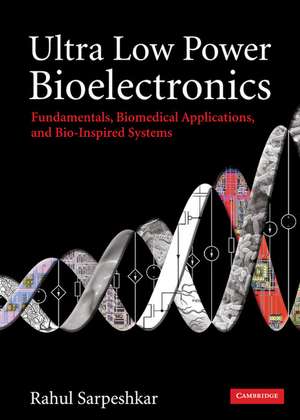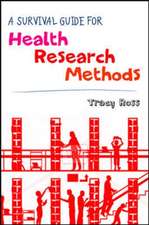Ultra Low Power Bioelectronics: Fundamentals, Biomedical Applications, and Bio-Inspired Systems
Autor Rahul Sarpeshkaren Limba Engleză Hardback – 21 feb 2010
Preț: 763.67 lei
Preț vechi: 887.99 lei
-14% Nou
Puncte Express: 1146
Preț estimativ în valută:
146.17€ • 158.83$ • 122.87£
146.17€ • 158.83$ • 122.87£
Carte tipărită la comandă
Livrare economică 21 aprilie-05 mai
Preluare comenzi: 021 569.72.76
Specificații
ISBN-13: 9780521857277
ISBN-10: 0521857279
Pagini: 910
Ilustrații: 406 b/w illus. 15 tables 150 exercises
Dimensiuni: 185 x 259 x 56 mm
Greutate: 1.59 kg
Editura: Cambridge University Press
Colecția Cambridge University Press
Locul publicării:Cambridge, United Kingdom
ISBN-10: 0521857279
Pagini: 910
Ilustrații: 406 b/w illus. 15 tables 150 exercises
Dimensiuni: 185 x 259 x 56 mm
Greutate: 1.59 kg
Editura: Cambridge University Press
Colecția Cambridge University Press
Locul publicării:Cambridge, United Kingdom
Cuprins
Part I. Foundations: Ten chapters lay a foundation in device physics, noise, and feedback systems including nano scales in a highly original fashion, emphasizing intuitive thinking. This foundation is important in designing and analyzing ultra-low-power systems in both electronics and biology; Part II. Low-Power Analog and Biomedical Circuits: Five chapters present building-block circuits that are useful for ultra-low-power biomedical electronics and analog electronic systems in general; Part III. Low-Power RF and Energy-Harvesting Circuits for Biomedical Systems: Three chapters provide an in-depth description of energy-efficient power and data radio-frequency (RF) links that are fundamental to biomedical systems; Part IV. Biomedical Electronic Systems: Two chapters provide an in-depth look at ultra-low-power implantable electronics and ultra-low-power noninvasive electronics for biomedical applications, respectively. Case studies for cochlear implants for the deaf, brain implants for the blind and paralyzed, wearable cardiac devices, and biomolecular sensing are provided; Part V. Principles for Ultra-Low-Power Analog and Digital Design: Two chapters discuss principles for ultra-low-power digital design and ultra-low-power analog and mixed-signal design, respectively. The chapters identify ten fundamental principles that are common in both biology and electronics, analog and digital design; Part VI. Bio-Inspired Systems: A chapter on neuromorphic electronics discusses electronics inspired by neurobiology followed by a chapter that discusses a novel form of electronics termed Cytomorphic Electronics, electronics inspired by cell biology. These chapters discuss applications of bio-inspired systems to engineering and medicine, deep connections between chemistry and electronics, and provide a unifying viewpoint of ultra-low-power design in biology and in electronics; Part VII. Energy Sources: A chapter on batteries and electrochemistry discusses how batteries work from a unique circuit viewpoint. The last chapter discusses energy harvesting in biomedical systems at portable scales (vibration and body heat) and at larger scales (low-power cars and solar cells). Principles of low-power design are shown to extend from small scales in electronics to larger scales and to non-electrical systems. This book reveals the deep connections between energy use and energy generation, vital for sustainable energy systems of the future.
Recenzii
'… an excellent overview of ten key fundamental principles related to ultra low power circuit and system design. Examples of many practical, experimental micro-power systems in cardiac, neural,and other medical-electronics applications make the text highly useful. Practitioners in this field will gain insight from his system-level analysis, which is presented at a level deeper than that found in most texts. In fact, the focus on systems thinking and connections made to a diverse set of problems - natural and man-made, from medical implants, to cells, to low-power cars - truly sets this book apart.' Tim Denison, Medtronic Fellow
'This truly interdisciplinary book is about much more than circuits. It contains the most comprehensive and deep treatment I have seen of the interplay and parallels between biology and circuits, and of how one discipline can inform the other. The comparisons between analog, digital, and biological implementations are fundamental and highly valuable. The breadth of the book is unique, ranging from feedback and antennas to battery chemistry.' Yannis Tsividis, Columbia University
'Sarpeshkar's focus on modeling cells as analog rather than digital circuits offers a new approach that will expand the frontiers of synthetic biology. Rahul has nicely laid a foundation that many of us in synthetic biology will be able to build on.' James Collins, Boston University
'This truly interdisciplinary book is about much more than circuits. It contains the most comprehensive and deep treatment I have seen of the interplay and parallels between biology and circuits, and of how one discipline can inform the other. The comparisons between analog, digital, and biological implementations are fundamental and highly valuable. The breadth of the book is unique, ranging from feedback and antennas to battery chemistry.' Yannis Tsividis, Columbia University
'Sarpeshkar's focus on modeling cells as analog rather than digital circuits offers a new approach that will expand the frontiers of synthetic biology. Rahul has nicely laid a foundation that many of us in synthetic biology will be able to build on.' James Collins, Boston University
Notă biografică
Descriere
Learn how to architect ultra low power robust electronics and how bio-inspired principles can revolutionize low power electronics design with this all-inclusive guide.







